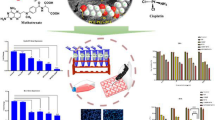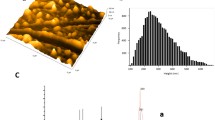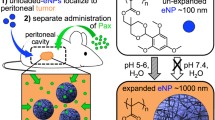Abstract
Poor cellular uptake contributes to high dose requirement and limited therapeutic efficacy of the platinum-based anticancer drug carboplatin. Delivery systems that can improve the cellular accumulation of carboplatin will, therefore, likely improve its therapeutic potential. The objective of this study was to evaluate nanoparticles composed of the biodegradable polymer, poly(d, l-lactide-co-glycolide), for carboplatin delivery to tumor cells. Carboplatin-loaded nanoparticles were formulated by double emulsion-solvent evaporation technique. Nanoparticles demonstrated sustained release of carboplatin over 7 days. Cellular uptake of carboplatin encapsulated in nanoparticles was several fold higher than that with free carboplatin in A549 (lung) and MA148 (ovarian) tumor cells. In vitro cytotoxicity studies showed that encapsulation of carboplatin in nanoparticles resulted in a remarkable reduction in the IC50 of carboplatin in several cell lines (up to 280-fold in some cells). Confocal microscopic analysis revealed the presence of carboplatin nanoparticles in several cellular compartments including lysosomes, cytoplasm, and the nucleus. These results demonstrate an enhanced cellular uptake of carboplatin through encapsulation in PLGA nanoparticles and suggest that improved therapeutic efficacy and reduced toxicity may be achieved with this approach.







Similar content being viewed by others
References
Helm CW, States JC. Enhancing the efficacy of cisplatin in ovarian cancer treatment—could arsenic have a role. J Ovarian Res. 2009;2:2.
Mutter R, Lu B, Carbone DP, Csiki I, Moretti L, Johnson DH, et al. A phase II study of celecoxib in combination with paclitaxel, carboplatin, and radiotherapy for patients with inoperable stage IIIA/B non-small cell lung cancer. Clin Cancer Res Off J Am Assoc Cancer Res. 2009;15(6):2158–65.
Aisner J, Sinibaldi V, Eisenberger M. Carboplatin in the treatment of squamous cell head and neck cancers. Semin Oncol. 1992;19(1 Suppl 2):60–5.
Möbus V, Wandt H, Frickhofen N, Bengala C, Champion K, Kimmig R, et al. Phase III trial of high-dose sequential chemotherapy with peripheral blood stem cell support compared with standard dose chemotherapy for first-line treatment of advanced ovarian cancer: Intergroup trial of the AGO-Ovar/AIO and EBMT. J Clin Oncol. 2007;25(27):4187–93.
Jakobsen A, Bertelsen K, Andersen JE, Havsteen H, Jakobsen P, Moeller KA, et al. Dose-effect study of carboplatin in ovarian cancer: a Danish Ovarian Cancer Group study. J Clin Oncol. 1997;15(1):193–8.
Stewart DJ. Mechanisms of resistance to cisplatin and carboplatin. Crit Rev Oncol Hematol. 2007;63(1):12–31.
Colombo N, Guthrie D, Chiari S, Parmar M, Qian W, Swart AM, et al. International Collaborative Ovarian Neoplasm trial 1: a randomized trial of adjuvant chemotherapy in women with early-stage ovarian cancer. J Natl Cancer Inst. 2003;95(2):125–32.
Rademaker-Lakhai JM, Terret C, Howell SB, Baud CM, De Boer RF, Pluim D, et al. A Phase I and pharmacological study of the platinum polymer AP5280 given as an intravenous infusion once every 3 weeks in patients with solid tumors. Clin Cancer Res Off J Am Assoc Cancer Res. 2004;10(10):3386–95.
Raynaud FI, Boxall FE, Goddard PM, Valenti M, Jones M, Murrer BA, et al. cis-Amminedichloro(2-methylpyridine) platinum(II) (AMD473), a novel sterically hindered platinum complex: in vivo activity, toxicology, and pharmacokinetics in mice. Clin Cancer Res Off J Am Assoc Cancer Res. 1997;3(11):2063–74.
Raymond E, Faivre S, Chaney S, Woynarowski J, Cvitkovic E. Cellular and molecular pharmacology of oxaliplatin. Mol Cancer Ther. 2002;1(3):227–35.
Sengupta P, Basu S, Soni S, Pandey A, Roy B, Oh MS, et al. Cholesterol-tethered platinum II-based supramolecular nanoparticle increases antitumor efficacy and reduces nephrotoxicity. Proc Natl Acad Sci U S A. 2012;109(28):11294–9.
Kelland L. The resurgence of platinum-based cancer chemotherapy. Nat Rev Cancer. 2007;7(8):573–84.
Hamelers IHL, van Loenen E, Staffhorst RWHM, de Kruijff B, de Kroon AIPM. Carboplatin nanocapsules: a highly cytotoxic, phospholipid-based formulation of carboplatin. Mol Cancer Ther. 2006;5(8):2007–12.
Chaudhury A, Das S, Bunte RM, Chiu GN. Potent therapeutic activity of folate receptor-targeted liposomal carboplatin in the localized treatment of intraperitoneally grown human ovarian tumor xenograft. Int J Nanomedicine. 2012;7:739–51.
Liu D, He C, Wang AZ, Lin W. Application of liposomal technologies for delivery of platinum analogs in oncology. Int J Nanomedicine. 2013;8:3309–19.
Prabha S, Sharma B, Labhasetwar V. Inhibition of tumor angiogenesis and growth by nanoparticle-mediated p53 gene therapy in mice. Cancer Gene Ther. 2012;19(8):530–7.
Patil YB, Swaminathan SK, Sadhukha T, Ma L, Panyam J. The use of nanoparticle-mediated targeted gene silencing and drug delivery to overcome tumor drug resistance. Biomaterials. 2010;31(2):358–65.
Patil Y, Sadhukha T, Ma L, Panyam J. Nanoparticle-mediated simultaneous and targeted delivery of paclitaxel and tariquidar overcomes tumor drug resistance. J Control Release. 2009;136(1):21–9.
Vasir JK, Labhasetwar V. Biodegradable nanoparticles for cytosolic delivery of therapeutics. Adv Drug Deliv Rev. 2007;59(8):718–28.
Mittal A, Chitkara D, Kumar N. HPLC method for the determination of carboplatin and paclitaxel with cremophorEL in an amphiphilic polymer matrix. J Chromatogr B Anal Technol Biomed Life Sci. 2007;855(2):211–9.
Nanjwade BK, Singh J, Parikh KA, Manvi FV. Preparation and evaluation of carboplatin biodegradable polymeric nanoparticles. Int J Pharm. 2010;385(1–2):176–80.
Qaddoumi MG, Ueda H, Yang J, Davda J, Labhasetwar V, Lee VH. The characteristics and mechanisms of uptake of PLGA nanoparticles in rabbit conjunctival epithelial cell layers. Pharm Res. 2004;21(4):641–8.
Prabha S, Labhasetwar V. Critical determinants in PLGA/PLA nanoparticle-mediated gene expression. Pharm Res. 2004;21(2):354–64.
Park J, Fong PM, Lu J, Russell KS, Booth CJ, Saltzman WM, et al. PEGylated PLGA nanoparticles for the improved delivery of doxorubicin. Nanomedicine Nanotechnol Biol Med. 2009;5(4):410–8.
Jacobson GB, Shinde R, Contag CH, Zare RN. Sustained release of drugs dispersed in polymer nanoparticles. Angew Chem. 2008;47(41):7880–2.
Shahani K, Swaminathan SK, Freeman D, Blum A, Ma L, Panyam J. Injectable sustained release microparticles of curcumin: a new concept for cancer chemoprevention. Cancer Res. 2010;70(11):4443–52.
Shahani K, Panyam J. Highly loaded, sustained-release microparticles of curcumin for chemoprevention. J Pharm Sci. 2011;100(7):2599–609.
Graf N, Bielenberg DR, Kolishetti N, Muus C, Banyard J, Farokhzad OC, et al. alpha(V)beta(3) integrin-targeted PLGA-PEG nanoparticles for enhanced anti-tumor efficacy of a Pt(IV) prodrug. ACS Nano. 2012;6(5):4530–9.
Nihant N, Schugens C, Grandfils C, Jerome R, Teyssie P. Polylactide microparticles prepared by double emulsion/evaporation technique. I. Effect of primary emulsion stability. Pharm Res. 1994;11(10):1479–84.
Nihant N, Schugens C, Grandfils C, Jerome R, Teyssie P. Polylactide microparticles prepared by double emulsion-evaporation: II. Effect of the poly (Lactide-co-Glycolide) composition on the stability of the primary and secondary emulsions. J Colloid Interface Sci. 1995;173(1):55–65.
Go RS, Adjei AA. Review of the comparative pharmacology and clinical activity of cisplatin and carboplatin. J Clin Oncol. 1999;17(1):409–22.
Baumann KH, Kim H, Rinke J, Plaum T, Wagner U, Reinartz S. Effects of alvocidib and carboplatin on ovarian cancer cells in vitro. Exp Oncol. 2013;35(3):168–73.
Samanta D, Kaufman J, Carbone DP, Datta PK. Long-term smoking mediated down-regulation of Smad3 induces resistance to carboplatin in non-small cell lung cancer. Neoplasia. 2012;14(7):644–55.
Wild R, Dings RP, Subramanian I, Ramakrishnan S. Carboplatin selectively induces the VEGF stress response in endothelial cells: Potentiation of antitumor activity by combination treatment with antibody to VEGF. Int J Cancer. 2004;110(3):343–51.
Gately DP, Howell SB. Cellular accumulation of the anticancer agent cisplatin: a review. Br J Cancer. 1993;67(6):1171–6.
Sahay G, Alakhova DY, Kabanov AV. Endocytosis of nanomedicines. J Control Release Off J Control Release Soc. 2010;145(3):182–95.
Davda J, Labhasetwar V. Characterization of nanoparticle uptake by endothelial cells. Int J Pharm. 2002;233(1–2):51–9.
Panyam J, Labhasetwar V. Sustained cytoplasmic delivery of drugs with intracellular receptors using biodegradable nanoparticles. Mol Pharm. 2004;1(1):77–84.
Pante N, Kann M. Nuclear pore complex is able to transport macromolecules with diameters of about 39 nm. Mol Biol Cell. 2002;13(2):425–34.
Tomaso MVD, Liddle P, Lafon-Hughes L, Reyes-Ábalos AL, Folle G. Chromatin Damage Patterns Shift According to Eu/Heterochromatin Replication 2013 2013-02-20.
Kang SJ, Durairaj C, Kompella UB, O’Brien JM, Grossniklaus HE. SUbconjunctival nanoparticle carboplatin in the treatment of murine retinoblastoma. Arch Ophthalmol. 2009;127(8):1043–7.
Oberoi HS, Laquer FC, Marky LA, Kabanov AV, Bronich TK. Core cross-linked block ionomer micelles as pH-responsive carriers for cis-diamminedichloroplatinum(II). J Control Release. 2011;153(1):64–72.
Acknowledgments
We thank the University Imaging Centers at the University of Minnesota for assistance with confocal microscopy. Parts of this work were carried out in the Characterization Facility, University of Minnesota, which receives partial support from NSF through the MRSEC program. We also thank the Dr. Rick Knurr, Geochemical Lab in the Department of Earth Sciences at the University of Minnesota for ICP-MS analysis.
Author information
Authors and Affiliations
Corresponding author
Additional information
Guest Editors: Mahavir B. Chougule and Chalet Tan
Rights and permissions
About this article
Cite this article
Sadhukha, T., Prabha, S. Encapsulation in Nanoparticles Improves Anti-cancer Efficacy of Carboplatin. AAPS PharmSciTech 15, 1029–1038 (2014). https://doi.org/10.1208/s12249-014-0139-2
Received:
Accepted:
Published:
Issue Date:
DOI: https://doi.org/10.1208/s12249-014-0139-2




